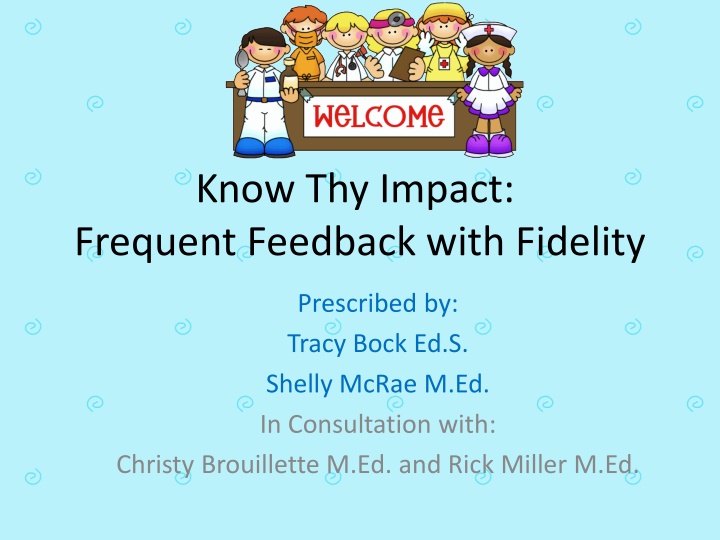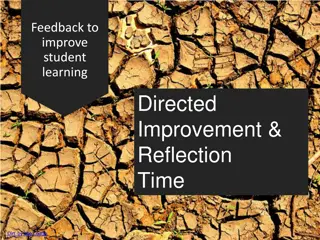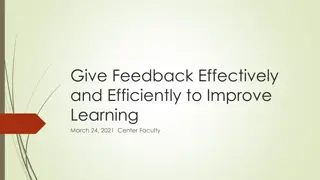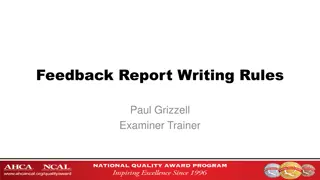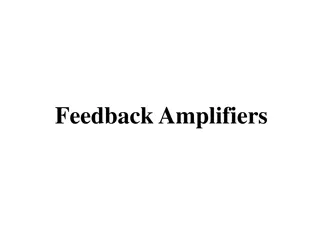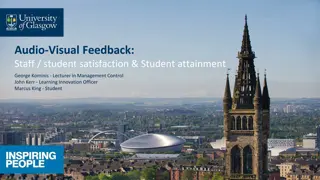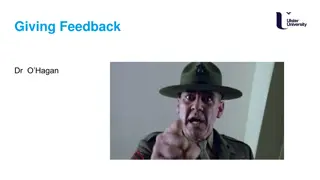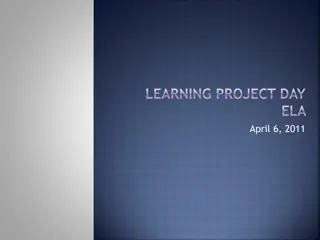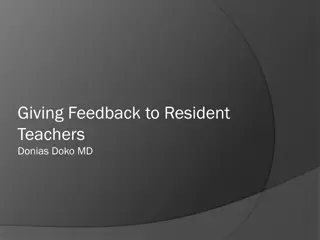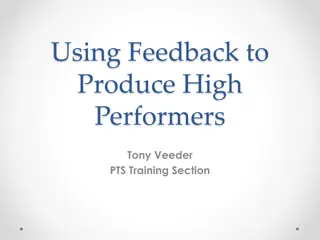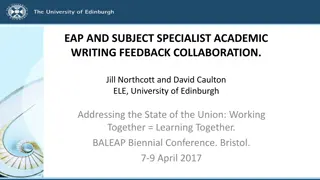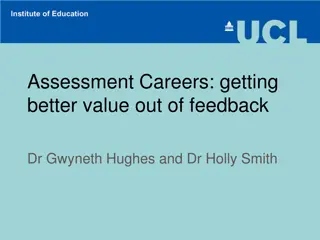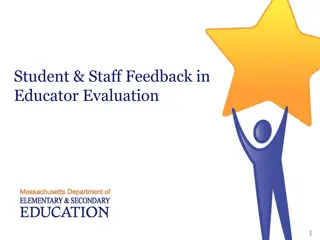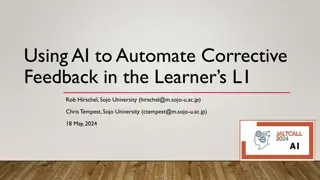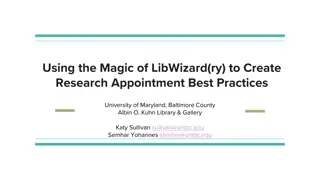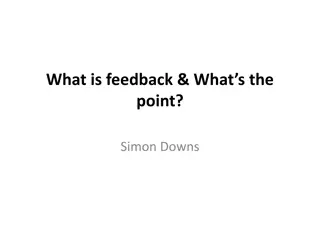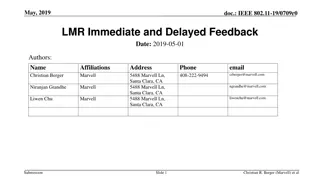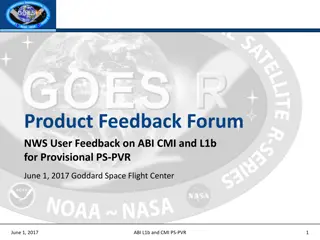Impactful Feedback Practices in Education
Engage in a journey of understanding feedback and monitoring in education, exploring their importance, defining concepts, and assessing their impact on various stakeholders. Dive into strategies for effective feedback delivery and monitoring techniques for continuous improvement in teaching practices.
Download Presentation

Please find below an Image/Link to download the presentation.
The content on the website is provided AS IS for your information and personal use only. It may not be sold, licensed, or shared on other websites without obtaining consent from the author.If you encounter any issues during the download, it is possible that the publisher has removed the file from their server.
You are allowed to download the files provided on this website for personal or commercial use, subject to the condition that they are used lawfully. All files are the property of their respective owners.
The content on the website is provided AS IS for your information and personal use only. It may not be sold, licensed, or shared on other websites without obtaining consent from the author.
E N D
Presentation Transcript
Know Thy Impact: Frequent Feedback with Fidelity Prescribed by: Tracy Bock Ed.S. Shelly McRae M.Ed. In Consultation with: Christy Brouillette M.Ed. and Rick Miller M.Ed.
OBJECTIVE Define feedback / monitoring Understand why feedback is important Summarize the purpose of feedback Compare current feedback/monitoring techniques to concepts learned today Apply concepts learned today to create a working definition of feedback
Beginning Activity On a sticky note : Define FEEDBACK in ONE WORD On a separate sticky note: Define MONITORING in ONE WORD
Why do we need feedback? Patients Districts Admins Teachers Students
Definition QUALITY: the degree of excellence of something. FREQUENT: doing something often; habitual. FEEDBACK: information about a person's performance of a task, used as a basis for improvement. FIDELITY: faithfulness to a cause or belief, demonstrated by continuing support.
One more definition MONITORING: observe and check the progress or quality of (something) over a period of time; THOUGHT: If you do not observe and check the progress of something (monitoring) how can you provide information about a person s performance which is used on the basis of improvement (feedback)?
Monitoring Activity Where are you with feedback stick it to the line 1 3 5 5 I have quality frequent feedback with fidelity and then some! 3 I have feedback OR I have monitoring, not sure about other definitions 1 I only give my opinion when someone needs it, not sure I have this feedback concept quite mastered
Our errors are surely not such awfully solemn things. In a world where we are so certain to incur them in spite of all our caution, a certain lightness of heart seems healthier than this excessive nervousness on their behalf. William James Monitoring and evaluating teaching strategies and their impact calls for self evaluation of our teaching practice. The errors will lead to midcourse correction and ultimately student learning. student learning.
WHAT WE DO AND HOW WE DO IT 5 step process 1. Collect and analyze data 2. Root causes WHY? 3. Set Goals 4. Choose strategies 5. Determine what success looks like
MONITORING / FEEDBACK 6THSTEP MONITORING Proficient Exemplary a)Teachers bring student work samples that provide evidence of strategy implementation a) Multiple work samples are included that show the progression of strategy implementation over time b) Teachers describe their implementation of the strategy including frequency, direct instruction/modeling, and feedback provided to students. b) Teachers observe colleagues in their use of the strategy and discuss observations during this meeting c)Teachers examine the student work samples to determine the quality of strategy work samples to determine the quality of strategy implementation c)Teachers discuss other situations where the strategy may be used d) Teachers examine the work samples to determine whether the strategy is having the desired impact Handout 3 e) Teachers support each other in the use of strategy through specific dialog, modeling, planning, etc. f)Teachers discuss the effectiveness of the strategy including whether to continue, modify, or stop the use of the selected strategies
Purpose of Feedback To reflect on the use of agreed upon instructional strategies (working or not) To discuss in detail what a strategy looked like (clear and concise) Used for administration to teacher, teacher to teacher, teacher to student, and STUDENT TO STUDENT To collaboratively decide on needed modifications
Teacher as Receiver of Feedback Know how to use three feedback questions Know how to use the four feedback levels Give and receive feedback Monitor and interpret own learning/teaching
Feedback should Focus on the task not the learner (teacher) Describe the what, how, and why Be manageable Be specific Be based on learners needs Reduce uncertainty Be unbiased Promote learning goals Lead to self-regulation Shute (2008) John Hattie Visible Learning For Teachers: Maximizing Impact on Learning
SAY AHHH.TURN AND CHAT Has your understanding about feedback and monitoring changed? Would you change your word on the bandage? Do you think your line plot will change after today? DISCUSS and JUSTIFY your reasoning with evidence you have heard so far..
FOUR CS FOR ADMINISTRATORS Clear course Constant feedback Frequent feedback with fidelity Just as with students, who are learning something new, teachers also need to receive feedback about what they are doing well Course Correction Celebrate success
If Then And Yes Celebrate Stay on course Review Are we doing what we set out to do Revisit our plan for implementation changes Some Is the analysis of the situation correct? If yes, see the question below If no, conduct a brief root cause analysis Revisit strategies for possible midcourse changes Handout 1 No Is the strategy the best chosen for the situation?
Handout 2 Suggested Actions Notes Collect and examine student work Know your strategies and what student work and behaviors should look like to accomplish your goal. Also, know what teacher/adult behavior should look like to accomplish your goal. Have this information as a visible reference. SELF MONITORING Videotape for personal reflection Examine and discuss work products Observe and discuss strategies Collect samples to show growth over time TEAM MONITORING Share successes and challenges Consider corrections and changes (even mid-course) Chart and post progress Access and utilize building and district content experts Discuss strategies one on one and with teams Conduct informal walk-through s and give immediate feedback on implementation of discussed strategies ADMIN MONITORING Recognize and celebrate team success often
1. Comments 2. Clarification 3. Criticism 4. Confirmation 5. Content development 6. Constructive reflection 7. Correction 8. Cons and pros 9. Commentary 10.Criterion (relative to standard) Critique Visible Learning and the Science of How We Learn 2014 (page 64) John Hattie & Gregory Yates
Praise -vs- Feedback Praise Feedback Sets classroom environment and norms Motivational : rewards/reinforcement Type of management strategy Shows approval from teacher Social learning about teacher s goals Closes critical learning gaps Scientifically based Based on information Task oriented Trusting environment
Feedback + Instruction = How feedback is received rather than how it is given. Must explain how to succeed to the learner. Attention on task and not themselves. At or just above current level of learning. Challenge the learner to achievable goals. Safe learning environment. Give opportunities to give peer feedback. Will provide teachers with feedback on their own teaching practices.
LETS REVIEW OUR OBJECTIVES Did we define feedback / monitoring Do you have a better understanding of why feedback is important Can you summarize the purpose of feedback Did you honestly compare your current feedback/monitoring techniques to the concepts presented today IF YES . THEN THERE IS ONE MORE THING TO DO
On the notecard provided please apply concepts learned today to create a working definition of feedback/monitoring in your own words EXIT TICKET EVALUATION
Thank you! Tracy Bock tracy.bock@rpsb.us Shelly McRae shelly.mcrae@rpsb.us Graphics by:
